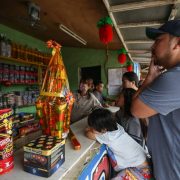Annus horribilis

1882 in the Philippines is best described as an annus horribilis, literally a “horrible year.” 1882 was a year of disaster and tribulation, with misfortune coming in threes: earthquakes, a cholera epidemic, and a devastating typhoon. The Diario de Manila reportage, hard to source in individual newspapers, was compiled in a pamphlet titled “Descripcion del huracan que el dia 20 Octubre 1882 asolo la capital y varias provincias de Filipinas (Description of the typhoon of October 20, 1882 that assaulted the capital and various provinces of the Philippines).” I read the texts with the 19th-century map of “Manila y sus arrabales (Manila and its suburbs)” to visualize the path of damage left in the typhoon’s wake. Names of prominent people and the extent of ruin of their homes added a human dimension to the primary source text.
Reports from Manila were disseminated from Madrid and Hong Kong, appearing as dispatches in various foreign newspapers. Reading these made the past sound so contemporary, with one newspaper narrating:
“So accustomed are the Filipinos to the last-named visitations that they scarcely count them as calamities worth consideration … the fair capital of Luzon will illustrate that marvelous resilience in recovering from adversity.”
Then, as now, Filipino resilience was both a blessing and a curse.
The official residences of the Spanish governor general and the archbishop of Manila were vacated, with the principals temporarily moved elsewhere for safety. The roof of the Tondo Church was blown off. The Tondo Theater was ruined. The Teatro Variedades was destroyed. All houses in Sampaloc were left without roofs. No house was left standing in the stretch between Divisoria and Dulumbayan. In Ermita, only one house, that of Mr. Macleod, was left standing. Nearby Malate lay in ruins.
Wind was so strong, it bent iron lightning rods, and iron roofs that could not be lifted, even by six to eight strong men, were blown off and found a distance away, rolled up like cigars. Back at the Jesuit-run Manila Observatory, the winds did not spare its anemometer, whose last reading of wind velocity was 144.4 miles per hour or 232.4 kilometers per hour!
Damage was estimated to be greater than that wrought by the great earthquake of 1880. Estimates of death and injury were not provided, though random fatalities and injuries were recorded. A corpse, presumed to be from a shipwreck, washed onto the shores of Ermita. No name was given to this remarkable typhoon, the strongest since 1831.
Manila Observatory said the lowest barometer reading at 11:40 a.m. was 727.60, whatever that means. This reminded me of the late Fr. Bernardo Ma. Perez, O.S.B., San Beda College rector, who consulted a Faura barometer in his room before declaring class suspensions. Ships and homes used to have barometers calibrated for the Philippines by Federico Faura, S.J., Manila Observatory director, and one of Jose Rizal’s mentors. He is the man honored by Padre Faura Street in Ermita, where the Supreme Court, University of the Philippines Manila, Robinsons mall, and Solidaridad Bookshop are to be found today.
A pity that Faura barometers are now museum artifacts or collector’s objects, not utilized for their primary function. When I texted a greedy friend, who has two Faura barometers, to find out the reading at the height of the last typhoon, he had to dig up the Fauras from storage, when these should be on the wall with his expensive paintings. Barometer needle pointed to the low end of “Baguio Intenso” (violent typhoon). Not yet a “Baguio Destructor” (destructive typhoon). Other indicators on the barometer were for: north winds, changeable weather, typhoon somewhat distant, and typhoon very near.
In the early 2000s, I came across Faura barometers in the Ermita antique shops. I borrowed these and showed them to Fr. Victor Badillo, S.J., at the Manila Observatory. Each barometer, he treated like a long-lost child and tested them by first knocking on the glass to make the needle move. If the needles were still sensitive, we took them on a ride up and down the observatory elevator, watching for them to twitch. I wish I had a smartphone then for selfies of an astronomer and a historian in an elevator with barometers. Father Badillo was respected in international astronomy; they gave him a place in the stars with “Asteroid 4866 Badillo.”
By the way, the 1882 pamphlet includes a drawing released by the Manila Observatory showing the path of the typhoon. Imagine what the 19th-century Jesuits were able to accomplish at the time without the computers and equipment that make for elaborate satellite imaging in Pagasa’s weather bulletins for the November 2025 typhoon that just passed and spared my part of the world. Reading the 1882 pamphlet made me wish Pagasa posted more regularly both on Facebook and their official website, which was static with only one bulletin hours out of date. To give us hope, Pagasa needs to improve storm bulletins in Filipino to simplify meteorological gobbledygook into texts a 5-year-old can understand.
—————-
Comments are welcome at ambeth.ocampo@inquirer.net
Ambeth is a Public Historian whose research covers 19th century Philippines: its art, culture, and the people who figure in the birth of the nation. Professor and former Chair, Department of History, Ateneo de Manila University, he writes a widely-read editorial page column for the Philippine Daily Inquirer, and has published over 30 books—the most recent being: Martial Law: Looking Back 15 (Anvil, 2021) and Yaman: History and Heritage in Philippine Money (Bangko Sentral ng Pilipinas, 2021).


















